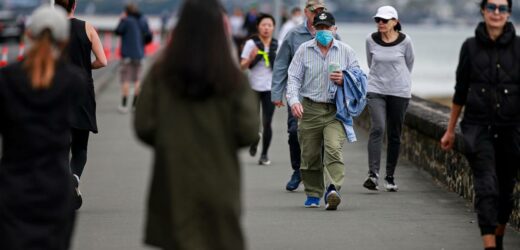COVID LATEST:
* New locations of interest in Waikato revealed after positive cases
* Parent of baby in ICU at Auckland Hospital tests positive for Covid
* Derek Cheng: Why level 2 in Auckland would resign the city to the fate of Melbourne, Sydney
* Opinion: Why we need gangs on board for the Covid fight
* Interest rate hike expected this week – regardless of lockdown call
New Zealand may be facing its most crucial week of the Delta outbreak as a pair of rogue cases force Hamilton and several other Waikato centres to join Aucklanders in lockdown.
A parent of a baby in Auckland City Hospital’s Neonatal Intensive Care Unit also tested positive for Covid-19, with movements in and out of the unit restricted.
All Auckland DHB staff in the unit are being tested, alongside babies and their families.
With another 33 cases reported in the community – half of them still unlinked – several experts say it’s unlikely Cabinet ministers will opt to move Auckland down to level 2 when they meet today.
Real doubt over Auckland level 2 move
Malaghan Institute director Graham Le Gros said he “really doubts” Auckland will come out of alert level 3 today.
Speaking to TVNZ’s Breakfast, he said: “The only way to get out of this mess now is to vaccinate, vaccinate, vaccinate.
“It’s the only way the whole country and Auckland will get out of this.”
Le Gros called on anyone and everyone to get the jab.
He said the vaccination rate was still too low, unfortunately.
“We’ve got to get to that group of people who are afraid of the needle … we’ve got to get to them.”
LISTEN LIVE TO NEWSTALK ZB
That also included people who had been listening to too many “rumours” about the vaccine.
Le Gros acknowledged that the Government’s aim of a 90 per cent vaccination rate might be a little too high.
At this point, he said he would like to see at least 85 per cent.
Le Gros said in the past, people had turned up to get vaccinated against other major diseases that affected the world – including polio – and had resulted in a 90 per cent vaccination rate because people understood they had a job to do.
“This is the time to be grown up, go and do your job and it won’t hurt – promise.”
Epidemiologist Michael Baker agreed there was a very low chance of moving to level 2 this week, “unfortunately”.
He believes the alert level system needs fine tuning – it was developed last year and much had changed since Delta.
Baker said everyone in New Zealand should expect the risk that the virus had seeded in their communities – so they should be following the level 2 restrictions.
More information was always needed before wider decisions could be made about the Waikato lockdown, he told The AM Show.
“We need to look very hard at the border round Auckland and the border between the North Island and the South Island.”
The soft border around Hamilton would not keep the virus in, he said. Contact tracers needed to quickly find the chain of transmission for the infected cases.
Inequality was a big issue in vaccination rates, he said. Only 30 per cent of Māori were double vaccinated.
He agreed 90 per cent vaccinationwas needed before getting out of level 3.
“Elimination is technically possible now but it would require a huge effort and it would be very tough on people.”
Adjusting our measures – by increasing jab rates – was the way out of the pandemic, Baker said.
Asked if elimination was over in practical terms, he said it was “looking like it.”
New Zealand had not managed to get out to the most marginalised people.
Waikato level 3 areas updated overnight
Waikato’s level 3 boundary has been confirmed overnight.
It includes Hamilton and entire Waikato District south of the Auckland lockdown border — including Raglan, Te Kauwhata, Ngaruawahia, and Huntly.
This extends beyond the area announced yesterday, and now extends south and east to areas like Tamahere, Eureka and Gordonton, and west to the Waikato West Coast.
Those areas will remain in level 3 for at least five days.
Prime Minister Jacinda Ardern says there will be ‘spot checks’ at the border, but mainly, they’re relying on people to do the right thing.
Why case numbers could track upwards
A two-week time-lag from when Auckland shifted to a softer lockdown a fortnight ago also meant that any resulting effect on case numbers could become apparent over coming days.
“One scenario is that we do start to see a trend, where the numbers will bounce around but clearly track upwards,” Covid-19 modeller Professor Michael Plank said.
“The other is that they hover somewhere in the ballpark of the teens or 20s, which will indicate contact tracing teams are still able to keep a lid on things at level 3.”
If numbers did start to grow, Plank said they might keep rising gradually, or sharply, as seen in Australia.
“Victoria had quite a rapid increase in cases – from 20 to around 1500 in six weeks – all with similar vaccination rates, and restrictions similar to level 3.”
Another expert, University of Auckland computational biologist Dr David Welch, said a continuing rise in cases – particularly unlinked ones – already made it clear that level 3 wasn’t working to quash the outbreak.
“Modelling suggested that the move from level 4 to level 3 was a risk – we have not landed on the right side of that risk.”
Eliminating Covid-19 in the short term, he added, would require a move back to level 4 – something Prime Minister Jacinda Ardern emphasised wouldn’t be considered by Cabinet today.
At a hastily-called media conference, she defended the level 3 step-down, which she said had been made on the advice of public health officials and still allowed efforts to stamp out the virus to continue.
She also pointed out that there was no evidence to suggest that the shift to level 3 had brought about a change in case numbers.
Hours earlier, it emerged two fresh community cases had been detected outside Auckland’s cordon – a person in Hamilton in their 40s and another in Raglan in their 50s – who so far hadn’t been linked either to each other, or the main outbreak.
Neither were vaccinated and both had moved around the region locally – prompting level 3 restrictions for Hamilton and Raglan, along with Huntly, Te Kauwhata and Ngaruawahia, for five days. The regions moved into alert level 3 at midnight Sunday.
While the Raglan case and their family were now in quarantine in Auckland, the Hamilton patient had been transferred to Waikato Hospital, where preparations were made to ensure there were no exposure events.
By yesterday afternoon, at least two Hamilton testing sites reached their capacity, with some people sent to other centres or asked to return today.
Waikato District Health Board was asking anyone symptomatic to get a test, and to follow guidance about each location of interest listed on Ministry of Health website.
“People who don’t meet the criteria, who aren’t symptomatic or have guidance to seek a test should call Healthline or their GP before they get a test.”
In Raglan, local ward councillor Lisa Thomson said there’d been an “amazing turnout” at a local pop-up testing station.
Earlier at the weekend, it was revealed an unvaccinated Auckland-based truck driver also tested positive for Covid-19, having visited a series of service stations in Waikato, Rangitikei and Manawatu.
Director-general of health Dr Ashley Bloomfield noted the driver was different from the Waikato cases, as they’d come from Auckland where undetected community spread wasn’t so much a concern.
Ardern also clarified the Waikato lockdowns were “discrete measures” taken separately to Auckland’s outbreak.
“So, we’ll be treating that distinct to what we’re dealing with in Auckland.”
Plank said it was concerning the cases had been infectious in the community for several days, and that there was no clear link to Auckland, meaning there could be more local cases to be found.
The events also showed that even with a relatively small number of cases in Auckland, he said, keeping the virus contained to one city was difficult.
“If the Auckland outbreak grows much larger, it will become even harder to prevent Covid spreading to other parts of New Zealand.”
Fellow Te Pūnaha Matatini modeller Shaun Hendy added that yesterday’s new cases made it very unlikely that Auckland could safely drop to level 2 – which could risk transmission elsewhere and force the rest of the country into level 3.
Because it appeared increasingly unlikely that Delta could be eliminated at level 3, Hendy said Aucklanders may have to stay at home until vaccination rates reached 90 per cent – something that could take weeks.
As at yesterday, just over half of eligible Auckland residents were fully vaccinated, with 84 per cent – or some 1.2 million people – having received their first dose.
On Saturday, more than 21,000 people in the region received their first jab, along with more than 4,500 receiving their second.
Nationally, nearly 80 per cent of Kiwis had now been given at least one shot – but there were still some 887,000 people who remained unvaccinated.
“Those who have not had a vaccine in New Zealand are currently in the minority but they are the vast majority of our cases,” Ardern said.
“That is because the vaccine works but also because the virus is literally finding unvaccinated people.”
She said that if vaccination rates in Hamilton and Raglan were 90 per cent or above, it was “highly unlikely” the Government would be imposing lockdowns.
“If the virus moves beyond the Auckland boundary and the places it moves to have low vaccination rates, today is an example of how will need to respond, so please get vaccinated today if you want to avoid level three in your community.”
Source: Read Full Article

/cloudfront-ap-southeast-2.images.arcpublishing.com/nzme/EDCPPBZP7F3FXOAMQD5J27NTGM.jpg)
/cloudfront-ap-southeast-2.images.arcpublishing.com/nzme/OVHXXUKFYZIJXCIDHKIPY4ZVSU.jpg)
/cloudfront-ap-southeast-2.images.arcpublishing.com/nzme/YQWQJVBWFR4YZCCXQLTXET4R3U.jpg)

